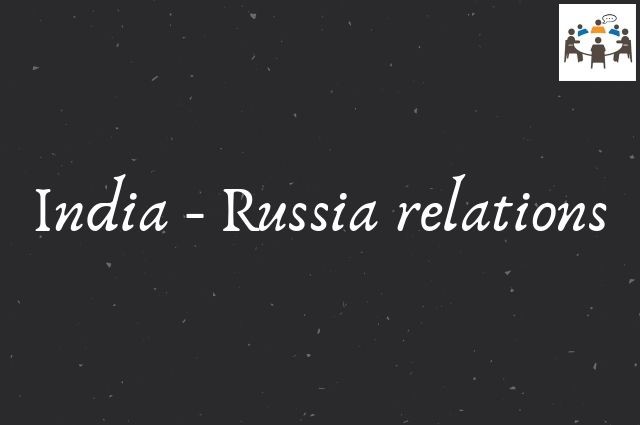History:
India had very strong bilateral ties with the USSR and the same relations got inherited with Russia later. When it comes to the relationship with the third world countries, India was Russia’s best partner since the 1950s. Pt. Jawahar Lal Nehru initiated the relationship by visiting USSR in 1955. Nikita Khrushchev’s, first secretary of the communist party, in his visit in the fall of 1955 announced that the USSR recognised Indian sovereignty over the disputed territories of Kashmir and Goa (under the Portuguese at that time). The Soviet Union took a neutral stance during the 1962 Indo-Sino War and it was strongly objected by China. The USSR leveraged its relations with China to have strong ties with India. In 1962 the Soviet Union agreed to transfer technology to co-produce the MIG-21s in India, which the USSR had already refused to China. In August 1971, India signed the Indo-Soviet Treaty of Friendship and Cooperation with the Soviet Union.
Right from the 1950s the USSR provided India with immense financial aid, helped us with Infrastructure and Industrial Development.
Economy:
In 2014, both the countries set a target of USD 30 bn investment target by 2025. By 2017, Russian investment in India amounted to USD 18 bn and Indian investment amounted to USD 13bn. Since they have already reached the USD30 bn mark, both the countries have raised the target for 2025 to USD 50 bn.
In 2017-18, bilateral trade was USD 10.69 billion, a 21.3% increase over 2016-17. With Russia having a trade surplus of USD 6.5 billion. India imports mineral fuels, mineral oils and products of their distillation, bituminous substances; precious or semiprecious stones and metals; Fertilizers; Nuclear reactors, boilers, machinery and mechanical appliances; Electrical machinery and equipment. And exports Nuclear reactors, boilers, machinery and mechanical appliances: parts thereof; Organic chemicals; Coffee, tea, mate and spices; Vehicles and parts and accessories thereof.
To further enhance the bilateral trade both the countries are planning on trading in national currencies and a free trade agreement.
Defence:
Russia has been a very generous defence partner to India right from the time of Independence. In terms of defence technology, the buyer-seller relationship has evolved into joint research and development. BrahMos missile system, licenced production of SU-30 fighter aircraft and T-90 battle tanks are some of the examples of joint co-operation. Russia is the biggest arms supplier to India. Soon an AK-203 assault rifle manufacturing plant will be set up in Amethi by joint cooperation and S-400 Air Defence Systems will be supplied to us. Russia has over the years supplied attack and transport aircraft and helicopters, tanks, aircraft carriers, submarines, frigates, assault rifles, bullet proof vests etc.
Both the countries regularly have the military exercise ‘INDRA’ and airforce exercise ‘Avia INDRA’.
Science & Technology:
Russia is an important partner to India in Nuclear Energy, Space Technology and other fields of Science.
- Nuclear Energy: In December 2014, both the countries signed an agreement for strengthening cooperation in the field of peaceful use of Nuclear Energy. Kudankulam Nuclear Power Plant (KKNPP) is being built in India with Russian cooperation. KKNPP Units 1 and 2 have already become operational. In 2015 an agreement on the localization of manufacturing of nuclear equipment in India was also concluded.
- Space Cooperation: Both the countries have a had a very long history of peaceful cooperation in the field of space. The first Indian satellite ‘Aryabhatta’ was launched on a Russian launch vehicle. India’s first man in space, Sqn. Ldr. Rakesh Sharma went with the Russians in a Russian module. Several MoUs have been signed to further enhance the cooperation.
- Science & Technology: The Working Group on Science and Technology functioning under IRIGC-TEC, the Integrated Long-Term Programme (ILTP) and the Basic Science Cooperation Programme are the three main institutional mechanisms for bilateral Science and Technology cooperation, while the Science Academies of the two countries promote inter-academy exchanges. Several other steps have also been taken to encourage a two-way exchange of technology.
Conclusion:
Russia has proved itself to be an all weather and evergreen friend of India. Both the countries have an inter-governmental body i.e. The Indo-Russian Inter-Governmental Commission (IRIGC). It conducts affairs at the governmental level between both countries. India has this extent of relationship only with Russia. From 2014, with India’s growing inclination towards the USA, there has been an increased closeness between China and Russia. Since Donald Trump’s aggressive behaviour towards its non-allies, China and Russia have also started co-operating at a higher level at BRICS and SCO also. India should handle these situations very tactfully and diplomatically so as to continue this strong and evergreen friendship.
Your Turn…
What are your thoughts on this topic? Express your point of view through the comment section below. And subscribe to our blog to read answers to the trending GD topics.
Copyright @ Group Discussion Ideas.

